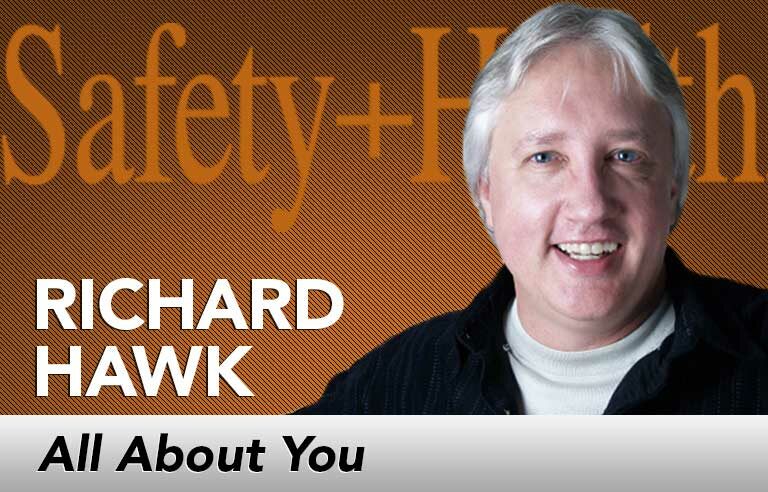All About You: Is your glass half full?

EDITOR’S NOTE: Motivating employees to work safely is part of the safety professional’s job. But who motivates the motivator? In this monthly column, veteran safety pro and professional speaker Richard Hawk offers his entertaining brand of wisdom to inspire safety pros to perform at their best.
Is the glass half empty or half full? Your response is commonly considered an indicator of whether you’re a pessimist or an optimist. There are even all kinds of humorous turns on the query. My favorite: “The professional trainer does not care if the glass is half full or half empty; he just knows that starting the discussion about it will give him 10 minutes to figure out why his PowerPoint presentation isn’t working.”
What determines if you’re an optimist or a pessimist? Is it whether you see opportunities where others see problems, or is it determined by your general outlook on life? These aren’t easy questions to answer, because labeling someone as “an optimist” or “a pessimist” is too confining a description about our psychology to be accurate all the time. Even the most optimistic person may experience times when he or she is pessimistic.
It works more like a sliding scale. Researchers have created several of these scales, such as the Unrealistic Optimism Scale and the Generalized Expectancy for Success Scale. Still, understanding the benefits of optimism (and, at times, pessimism) and then using what we learn to our benefit can improve our lives dramatically. As a motivational safety speaker, I’m required to be optimistic most of the time. Here are two habits that help me fulfill that requirement.
Picture things you enjoy
Can you learn to be more optimistic? Yes. Although you have a natural baseline that may predispose you to a level of optimism vs. pessimism, research has shown that you still can increase your level of optimism. Here’s something I do to slide further along the positive side of the scale: Throughout the day, I notice and think about the things I like, such as a cup of coffee, music, a friend’s voice on the phone and even sitting in a comfortable chair. Are things I don’t enjoy going on today? Of course, and some shouldn’t be ignored, but I don’t need to dwell on my problems.
By noticing the positive most of the time, I can’t ruminate about the negative. Certainly, when you’re doing an inspection, conducting an incident investigation or evaluating yourself, you’ve got to be critical. But that’s different than having a gloomy outlook or dwelling on what isn’t right. Even when things are going south, consider what Winston Churchill concluded: “A pessimist sees the difficulty in every opportunity; an optimist sees the opportunity in every difficulty.”
Realize it will pass
To help handle negative events, I tell myself, “This isn’t permanent.” You’ve probably heard it as, “This too shall pass.” Realizing a bad situation is only temporary and doesn’t determine your entire world is a common trait among people who are usually optimistic. The opposite view can even lead to depression. It’s a common thread among people who regularly suffer from depression to feel that their problems are permanent.
Think about something nasty that happened to you several years ago. Does it still dominate your thoughts today? Unless it involves severe grief, it doesn’t. But when it was happening, it may have seemed world-shaking. Realizing that today’s troubles will fade quickly helps me stay upbeat. Most times you forget about a distasteful event in a few weeks or less.
The optimism bias
One kind of optimism – which we safety and health professionals sometimes have to contend with – can be harmful. It’s when a worker is overly optimistic about his or her ability to avoid hazards and not get injured. It also can cause us to overrate our driving skills and ability to control situations.
Tali Sharot, a neuroscientist at University College London, recommended during her 2012 TED talk on the topic that we should be aware of our optimism bias. However, she still recommends being optimistic, because optimism “changes objective reality. It acts as a self-fulfilling prophecy.” She added that “whatever happens, whether you succeed or you fail, people with high expectations always feel better.”
This article represents the views of the author and should not be construed as a National Safety Council endorsement.
Richard Hawk helps companies around the world create more vibrant safety cultures by showing them how to make safety fun. As a professional speaker, author and musician, he also inspires employees to focus better and enlightens safety leaders about ways to increase their influence. To learn more about Richard, visit makesafetyfun.com.
Direct to your inbox: Sign up to be notified in email about new "All About You" columns.
Listen on Soundcloud or Stitcher
Post a comment to this article
Safety+Health welcomes comments that promote respectful dialogue. Please stay on topic. Comments that contain personal attacks, profanity or abusive language – or those aggressively promoting products or services – will be removed. We reserve the right to determine which comments violate our comment policy. (Anonymous comments are welcome; merely skip the “name” field in the comment box. An email address is required but will not be included with your comment.)

